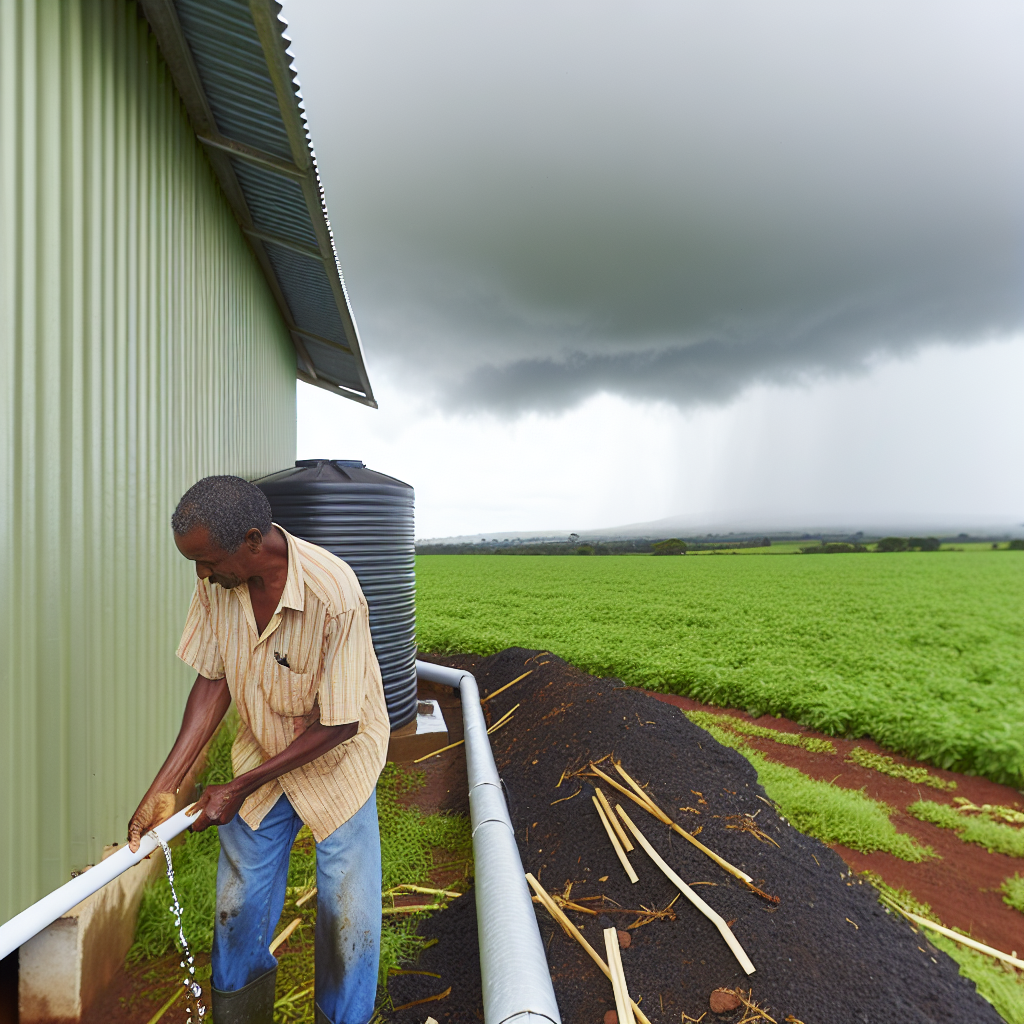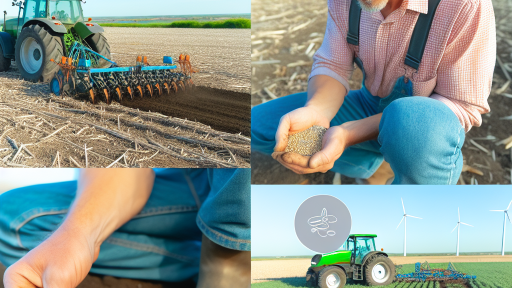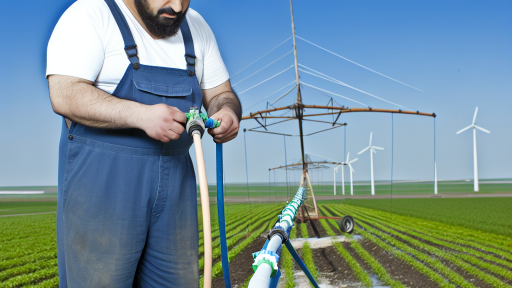Introduction to Rainwater Harvesting
Rainwater harvesting captures and stores rain for future use.
It offers a sustainable solution for water scarcity in agriculture.
This technique is vital for farmers facing unpredictable rainfall patterns.
Additionally, it helps to recharge groundwater levels.
Farmers can utilize harvested rainwater for irrigation and livestock watering.
Moreover, using rainwater can reduce reliance on expensive water sources.
This process also minimizes soil erosion and runoff during heavy rains.
Consequently, it promotes a healthier and more productive farming ecosystem.
Significance of Rainwater Harvesting for Farmers
Rainwater harvesting provides numerous benefits for agricultural practices.
First, it enhances water availability during dry periods.
This availability improves crop yields and farming efficiency.
Also, it reduces the risk of crop failure due to drought.
Farmers can save on water bills when utilizing collected rainwater.
Thus, it leads to a more economically viable farming operation.
Furthermore, harvested rainwater is typically free from contaminants.
Transform Your Agribusiness
Unlock your farm's potential with expert advice tailored to your needs. Get actionable steps that drive real results.
Get StartedConsequently, this reduces the need for costly water treatment processes.
Environmental Impact
Implementing rainwater harvesting contributes positively to the environment.
It decreases stormwater runoff, which can pollute water bodies.
Additionally, this practice helps to conserve water resources.
By capturing rainwater, farmers support biodiversity in their ecosystems.
Moreover, it promotes soil health by maintaining moisture levels.
Efficient water use through rainwater harvesting aids in climate resilience.
Farmers adopting this technique are less vulnerable to climate change impacts.
Benefits of Rainwater Harvesting in Agriculture
Conservation of Water Resources
Rainwater harvesting conserves precious water resources.
This technique reduces dependency on groundwater.
Consequently, it helps maintain the water table level.
Farmers can collect and store rainwater during wet seasons.
Thus, they ensure availability during dry spells.
Cost-effective Solution
Implementing rainwater harvesting systems is cost-effective.
Farmers can significantly lower their irrigation costs.
Moreover, it decreases expenditure on water bills.
Investments in storage tanks and collection systems pay off over time.
Ultimately, farmers experience improved profitability.
Improvement in Crop Yields
Rainwater harvesting directly enhances crop yields.
More consistent water supply promotes healthy growth.
Additionally, collected rainwater often contains fewer salts.
This leads to better soil quality and fertility.
Furthermore, it reduces the risk of crop failure.
Environmental Sustainability
Harvesting rainwater contributes to environmental sustainability.
Showcase Your Farming Business
Publish your professional farming services profile on our blog for a one-time fee of $200 and reach a dedicated audience of farmers and agribusiness owners.
Publish Your ProfileThis method reduces surface runoff and erosion.
Moreover, it helps recharge groundwater aquifers.
Farmers can contribute to local ecosystems through responsible practices.
In addition, this approach promotes biodiversity in agricultural areas.
Resilience to Climate Change
Rainwater harvesting enhances farm resilience to climate change.
As weather patterns become erratic, this technique becomes crucial.
It allows farmers to adapt to changing precipitation patterns.
Consequently, their reliance on conventional irrigation diminishes.
Farmers are better equipped to handle droughts and floods.
Traditional vs. Modern Rainwater Harvesting Techniques
Overview of Traditional Techniques
Farmers have relied on traditional techniques for centuries.
These methods often reflect the local climate and available resources.
Common techniques include rooftop collection and surface runoff harvesting.
Farmers channel rainwater from roofs into storage barrels.
They also build small ponds or ditches to catch surface water.
These methods are cost-effective and simple to implement.
However, they may have limitations in efficiency and storage capacity.
Advantages of Traditional Techniques
Traditional techniques often integrate well with local ecosystems.
Farmers experience less disruption to their land and soil health.
Additionally, these methods require minimal financial investment.
Local knowledge and practices are preserved through these techniques.
Moreover, they promote community collaboration among farmers.
Introduction to Modern Techniques
Modern rainwater harvesting offers advanced solutions for water collection.
These approaches utilize technology and scientific principles.
Popular modern methods include rainwater tanks and underground reservoirs.
Some farmers implement smart sensors to monitor water levels.
Drip irrigation systems also enhance water efficiency in modern farming.
Benefits of Modern Techniques
Modern techniques improve water management significantly.
They can store larger quantities of rainwater more effectively.
Additionally, these systems reduce evaporation losses.
Farmers can ensure consistent water supply throughout the year.
Ultimately, modern methods can lead to increased crop yields.
Comparative Analysis
Both techniques have unique benefits for farmers.
Traditionally, methods rely on local knowledge and resource availability.
In contrast, modern methods leverage technological advancements for efficiency.
Farmers should assess their specific needs and circumstances.
They can then choose the most appropriate harvesting technique.
Gain More Insights: Recycling Organic Materials for Soil Health
Step-by-Step Guide to Setting Up a Rainwater Harvesting System
Understanding Rainwater Harvesting
Rainwater harvesting collects and stores rain for future use.
This technique conserves water and reduces utility bills.
It also minimizes the impact of stormwater runoff.
Showcase Your Farming Business
Publish your professional farming services profile on our blog for a one-time fee of $200 and reach a dedicated audience of farmers and agribusiness owners.
Publish Your ProfileSelecting the Right Location
Start by choosing an appropriate collection surface.
Roofs are ideal for collecting rainwater.
Ensure that the roof material is safe for drinking water.
Gathering Necessary Materials
You will need several components for the system.
- Gutters and downspouts for channeling rainwater.
- A storage tank or cistern for holding the water.
- A filtration system to purify the water.
Additionally, check local regulations regarding system installation.
Installing the Collection System
Begin by installing gutters along the roof’s edge.
Connect downspouts from the gutters to the storage tank.
Ensure that the downward slope directs water effectively.
Setting Up the Storage Tank
Select a tank that meets your water storage needs.
Place the tank on stable ground and ensure stability.
Install a lid to prevent contamination from debris and pests.
Implementing a Filtration System
Consider a first-flush diverter to capture initial rainwater.
This device discards the first flow of water, which may contain contaminants.
Install a filter at the tank’s inlet to further purify the water.
Maintaining the System
Regular maintenance is essential for effective rainwater harvesting.
Clean gutters and filters to remove debris regularly.
Inspect the tank for leaks or damage routinely.
Utilization of Collected Water
Use collected rainwater for irrigation and gardening.
Consider using it for washing vehicles and outdoor cleaning.
A rainwater harvesting system can support various agricultural needs.
You Might Also Like: Smart Irrigation Controllers for Efficient Water Use
Types of Rainwater Storage
Tanks
Rainwater tanks provide a reliable storage option for farmers.
They come in various sizes and materials to suit different needs.
Plastic and metal tanks are the most common choices.
Farmers can place tanks above or below ground.
Above-ground tanks are easier to install and maintain.
Meanwhile, below-ground tanks conserve space and keep water cooler.
Proper maintenance ensures longevity and efficiency.
Regular cleaning prevents algae growth and contamination.
Pits
Digging pits allows for an alternative approach to rainwater harvesting.
Pits can capture runoff and facilitate groundwater replenishment.
They should be deep enough to hold significant water amounts.
Additionally, pits can collect water from various surfaces.
Farmers can enhance pits with vegetation to improve aesthetics.
Furthermore, vegetation helps reduce evaporation rates.
Using natural filters in the pit can enhance water quality.
Barrels
Rainwater barrels are another practical option for farmers.
They are typically smaller and easier to handle than tanks.
Barrels can be placed near downspouts for easy collection.
Farmers should choose barrels made from durable materials.
Showcase Your Farming Business
Publish your professional farming services profile on our blog for a one-time fee of $200 and reach a dedicated audience of farmers and agribusiness owners.
Publish Your ProfileFood-grade barrels ensure the water remains safe for various uses.
Regularly checking for leaks can prevent water loss.
Additionally, using a screen can filter debris before it enters the barrel.
See Related Content: Conservation Tillage Techniques For Climate Resilience

Maintenance and Monitoring of Rainwater Harvesting Systems
Importance of Regular Maintenance
Regular maintenance ensures rainwater harvesting systems operate efficiently.
Farmers should conduct routine checks to identify any potential issues early.
This proactive approach saves time and money in the long run.
Routine Inspections
Inspecting the system at least twice a year is essential.
Look for debris in gutters and filters to ensure proper water flow.
Check for any signs of wear and tear in the storage tanks.
Cleansing the entire system periodically promotes better water quality.
Monitoring Water Quality
Monitoring water quality is crucial to ensure safe usage.
Farmers should test rainwater for contaminants regularly.
Utilizing basic water testing kits can simplify this process.
Cloudy water may indicate the need for additional filtration.
System Performance Evaluation
Evaluating system performance helps assess its effectiveness.
Farmers can track the amount of water harvested versus rainfall.
This data provides insights into whether adjustments are necessary.
Utilizing Technology for Monitoring
Modern technology can significantly aid in monitoring systems.
Installing sensors can provide real-time data on water levels.
Mobile apps can remind farmers of scheduled maintenance tasks.
Data analytics tools can identify trends in water conservation efforts.
Repairs and Upgrades
Identifying components needing repair is crucial for system longevity.
Farmers should prioritize repairs to avoid more extensive damage later.
Upgrading outdated systems can enhance efficiency and capacity.
New filtration systems can improve the quality of collected water.
Documentation and Record Keeping
Keeping detailed records of maintenance activities is essential.
This documentation aids in identifying patterns over time.
Farmers can use this information to improve their practices.
A well-maintained log boosts the transparency of farming operations.
Explore Further: Benefits of Carbon Sequestration in Agriculture
Common Challenges in Rainwater Harvesting and Their Solutions
Understanding Rainwater Harvesting Challenges
Farmers often face various challenges in their rainwater harvesting efforts.
These challenges can hinder effective water collection strategies.
Recognizing these obstacles is the first step towards finding solutions.
Common Issues Faced by Farmers
One major challenge is inadequate storage capacity.
Limited storage makes it difficult to retain enough water for dry periods.
Moreover, improper maintenance of storage facilities leads to contamination.
Another issue is inefficient collection systems.
Poorly designed gutters and downspouts can reduce water capture significantly.
Solutions to Improve Water Harvesting
Farmers can enhance storage by investing in larger tanks.
Showcase Your Farming Business
Publish your professional farming services profile on our blog for a one-time fee of $200 and reach a dedicated audience of farmers and agribusiness owners.
Publish Your ProfileUsing materials like food-grade plastic can prevent contamination.
Regular maintenance of storage systems ensures water quality remains high.
Upgrading collection systems is also crucial.
Installing properly designed gutters increases rainwater capture efficiency.
Adapting to Local Conditions
Farmers must consider local climate patterns when designing their systems.
In regions with sporadic rainfall, optimizing storage capacity is essential.
Additionally, adapting collection methods to seasonal variations boosts efficiency.
Community and Knowledge Sharing
Collaboration among farmers can lead to better solutions.
Sharing best practices enhances overall effectiveness in rainwater harvesting.
Joining local agricultural organizations provides access to valuable resources.
Farmers can learn from others’ experiences to overcome common challenges.
Case Studies: Successful Rainwater Harvesting Practices Around the World
Innovative Techniques in India
In India, many farmers successfully implement rainwater harvesting systems.
The use of check dams has transformed arid areas.
These structures catch and store rainwater for irrigation.
Farmers in Rajasthan witness improved crop yields through this method.
Furthermore, this technique strengthens the local economy.
Community Efforts in South Africa
In South Africa, community-based rainwater harvesting programs thrive.
Participating farmers utilize simple cisterns and barrels.
These systems collect rainwater from rooftops and surfaces.
Consequently, they ensure a steady water supply during dry periods.
This approach fosters collaboration among farmers, creating resilient communities.
Tech-Driven Solutions in Australia
Australian farmers leverage advanced technology for rainwater harvesting.
Many use smart sensors to monitor water levels effectively.
This technology optimizes water usage across their farms.
As a result, crop health and productivity significantly improve.
Additionally, these innovations attract younger farmers to agriculture.
Traditional Methods in the Philippines
The Philippines showcases traditional rainwater harvesting practices.
Farmers often build rooftop catchment systems to store rainfall.
These systems supply water for domestic use and irrigation.
People in rural areas benefit immensely from this sustainable practice.
It also reduces dependency on municipal water sources.
Impactful Policies in Brazil
In Brazil, government initiatives promote rainwater harvesting.
These policies support farmers in adopting efficient systems.
Training programs teach effective rainwater management techniques.
With these efforts, agricultural productivity in semi-arid regions increases.
Moreover, this approach enhances environmental sustainability.
Additional Resources
11 Ways Farmers Are Adapting to Climate Change | Earth.Org
Native Americans farming practices hold potential amid climate …




